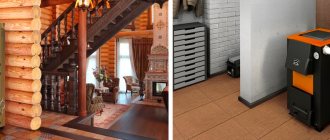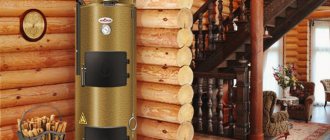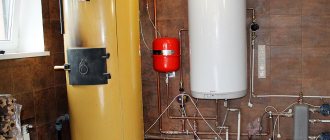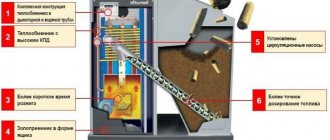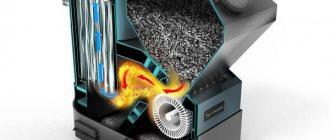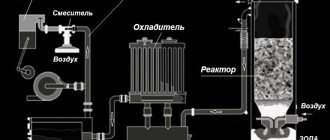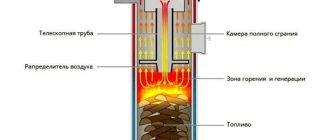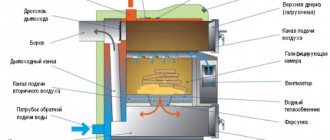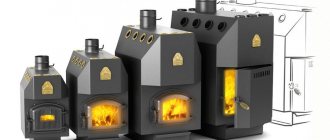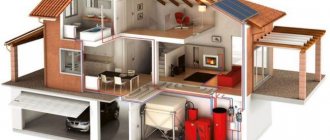The heating equipment market offers a wide selection of modern equipment, among which long-burning solid fuel boilers occupy a special place. Manufacturers produce models of different capacities for homes, cottages, apartments, and utility rooms. These devices have their own characteristics that need to be taken into account when purchasing.
What is a long-burning solid fuel boiler?
Many homeowners prefer to install heating devices so as not to depend on the heating network. This unit looks ideal in a summer cottage or country house. Now there is a wide variety of heating equipment, but models running on solid fuel are considered more economical compared to gas and diesel units. Users note autonomy and low power consumption among their positive qualities.
Design
Before moving on to the operating principle of such installations, you should understand what key elements they are assembled from.
The structure of solid fuel equipment is as follows:
- cylindrical body - combustion chamber;
- door through which firewood is loaded;
- ash pan;
- air distributor - a circle made of metal with a special hole in the middle, under the influence of its own weight it presses the fuel and, when the wood burns, it lowers;
- the air supply pipe, which is connected to the distributor and is located in the upper part of the boiler, thanks to the damper you can regulate the air supply;
- chimney;
- heat exchanger
As you can see, the design of a standard boiler is not that complicated. For this reason, such an installation is now often assembled with one’s own hands. But during the assembly process many details must be taken into account.
Operating principle
Solid fuel heating boilers operate on the “top combustion” principle. Before oxygen enters the firebox, it must be heated. This is done so that ultimately less combustion waste, that is, ash and soot, is produced.
Oxygen is supplied from top to bottom, so the wood laid in the top layer begins to burn first. After they are burned, the air supply to the bottom of the fuel is activated. This principle is constant and allows you to use firewood more efficiently. This technology is necessary for a long combustion process.
As you can see, the device is economical and at the same time remains environmentally friendly. Naturally, in order to achieve such characteristics, you should choose the equipment wisely so that it is made of fire-resistant materials. Only in this case will the installation produce maximum efficiency while remaining safe in operation.
Advantages
If a boiler intended for heating a country house has built-in automation, then its maintenance will not take much time and effort from the owner. All that is required is to lay a new portion of firewood after a certain time.
Key advantages of the units:
- availability of both equipment and fuel;
- environmental friendliness;
- the use of various types of fuel is allowed;
- high efficiency;
- Ease of Management;
- safe operation.
An important advantage of wood-burning boilers is their complete energy independence. This makes operation more convenient, while simultaneously expanding the scope of use of the units. This feature is often paid attention to by those users who plan to install equipment in areas where there are periodic interruptions in the power supply or where there is no power supply at all.
There are also universal models that require electricity to operate. If the installation is used correctly, it will remain safe. This is explained by the fact that firewood is not explosive compared to gas or diesel fuel. Management is simple and does not require special knowledge or skills.
Flaws
The equipment, which is popularly called a “potbelly stove,” has its disadvantages, which you need to familiarize yourself with before purchasing.
The following disadvantages are identified:
- higher cost compared to classic solid fuel boilers;
- when loading firewood, you should follow the manufacturer’s recommendations;
- universal models are dependent on electricity;
- Only certain fuel cells are suitable (humidity, size);
- due to the deep firebox, it is sometimes difficult to light firewood if the load is incomplete;
- During operation, it will not be possible to reload small fuel, for example, sawdust.
If you take into account all these disadvantages and wisely approach the issue of choosing a device, it will not only last for many years, but will be economical and effective.
Buffer tank (heat accumulator)
If we exclude devices operating on granular fuel, then solid fuel boilers are characterized by uneven operation; the increase and decrease in temperature in the furnace are cyclical. In order to smooth out temperature fluctuations in the heating system, a heat accumulator (buffer tank) is used. The design is a sealed tank with a heat-insulating layer, most often cylindrical in shape.
Two or more pairs of coils (heat exchangers) are embedded in this tank, through which heated coolant from the boiler enters the tank and is distributed throughout the heating system. This scheme allows excess energy at the peak of combustion to be accumulated in a heat accumulator, so that later, when the fuel burns out, heated water can be used to maintain the set temperature. You can read more about them here.
Classification of long-burning boilers
In total, there are several groups of equipment that differ in specific characteristics: how the fuel is burned, the material of manufacture, the type of fuel used, and so on. All these features affect the power and, accordingly, the efficiency of the installation.
By fuel combustion method
There are manual and automatic methods.
Manual loading boilers are of the following types:
- Cyclical. Such equipment uses the previously discussed patented method of top combustion. That is, the upper part of the wood is burned first, and then air is supplied to the lower area of the chamber. Such boilers have a simple and at the same time reliable design. There are models that, after one load of firewood, can work for 70 hours. If the fuel is coal, then the operating time can last up to 7 days.
- Pyrolysis. Due to the lack of oxygen and under the influence of high temperature, gas is released from the firewood, which is burned using the pyrolysis method. With this method, a minimal amount of soot and ash is formed, and the fuel burns almost completely. A single stack of firewood will allow the boiler to operate for 8–10 hours.
A separate category includes pellet equipment, which provides automatic fuel supply.
According to the material of manufacture
Nowadays, two main materials are used for the production of solid fuel boilers: steel and cast iron. Each of them has its own characteristics. Steel is a durable material that allows you to reduce the thickness of the walls of the boiler and its heat exchanger. Because of this, the final cost of the equipment is reduced.
This is also the main drawback. Although boilers require long-term combustion, their service life will be several times shorter than that of their cast iron counterpart. To increase service life, specialists line the steel firebox with refractory bricks.
Massive heating devices are made from cast iron, the power rating of which starts at 20 kW. The material itself is not very durable and is especially unstable to impact loads. For this reason, manufacturers increase the thickness of the cast iron layer when making the walls and firebox. The key disadvantage of such devices is their heavy weight, which can reach 300 kg. This material is also sensitive to temperature changes, so it is not recommended to load cold firewood into the chamber.
By type of fuel used
Boilers can operate not only on wood, but also on other materials.
In total, there are 4 types of devices, which differ in the type of fuel loaded:
- Firewood. Used in standard devices. It is important to use wood with a moisture content of no more than 20%.
- Coal . The special design allows the boiler to easily withstand high temperatures.
- Pellets. This is a specific type of fuel, which is compressed pellets from wood waste. The units are considered the most convenient to use, since pellets do not need to be loaded as often as firewood or coal. They are more expensive compared to classic analogues.
- Different types of fuel. Such boilers are considered universal. For example, a device running on coal can be equipped with electric heating elements.
Each type has its own advantages and disadvantages. The simplest and most understandable boiler is the one that runs on wood. Universal and pellet models are economical and easy to use, but are more expensive.
Dual-circuit
These are special devices. The fuel for them can be: firewood, coal, pellets, and so on. In addition to the main heating function, the device provides the house with hot water. The boiler can be equipped with a boiler or a coil.
However, in such equipment it is quite problematic to regulate the temperature of the prepared water. In fact, this is the only drawback, but this problem can be solved. To regulate the temperature of the liquid, the boiler must be connected to an indirect heating boiler.
There is a coil in the tank of the storage water heater through which hot boiler water passes. It serves as a heat exchanger and allows the liquid to be heated evenly. Thanks to the large surface area, this process does not take much time.
The key difference between dual-circuit models is that they are capable of both heating rooms and heating water.
Advantages of solid fuel boilers:
- have a relatively low cost;
- easy to use;
- operate on various types of fuel;
- reliable;
- economical;
- do not require special skills for maintenance.
The devices have a simple operating principle. The task of the main circuit is to maintain a stable temperature in the heating pipes. When this indicator decreases, a special sensor is triggered.
The function of the second circuit is to maintain the temperature of the water that is not used for heating. If the liquid cools down, the sensor is immediately activated, giving a corresponding signal. When messages arrive from both sensors, the boiler begins to burn fuel until the water in the circuits heats up. To save fuel, it is recommended to install an additional boiler.
A long-burning solid fuel boiler with a water circuit is a universal device that simultaneously solves 2 problems, which is why it is very popular.
Automation
Modern solid fuel boilers are equipped with a whole range of automatic devices that minimize human participation in servicing the operating unit. The scope of automatic regulation includes the following functions:
- compliance with the temperature regime in the system;
- control of pumps in the main and auxiliary (admixture circuit) circuits;
- maintaining the set temperature of hot water supply;
- control of coolant flows using a three-way valve.
If there is an automation unit , a person only needs to set the required temperature and load fuel, then the combustion process is controlled automatically according to the specified settings by controlling the supply of oxygen to the firebox . If heating is carried out using a pellet unit, then the fuel is loaded automatically.
Operating principle of three-way valve
If there is a three-way valve, the system works on the principle of mixing hot water from the boiler into the main flow when the temperature drops below the set one. This principle allows you to heat only the required amount of water. It can be supplied either directly from the boiler or from a buffer tank. At the same time, it can be heated by alternative sources, for example, a solar collector.
Criterias of choice
Modern boilers differ in many ways, and when choosing, you should start from several basic criteria. Despite their heavy weight and large dimensions, such installations continue to be in demand. This is primarily due to their availability.
Fuel type
When purchasing a unit, you need to choose what type of fuel it will operate on. Modern devices operate on ordinary wood, peat, various types of coal, and so on.
The choice of a certain type of raw material affects heat transfer, operating time from one load and operating comfort. If wood is used, then preference should be given to deciduous and soft-leaved species.
Fuel should be stored in a ventilated area. For this purpose, a separate closed place is allocated, where precipitation does not fall. Some types of wood do not burn well, while others may not even be laid dry. Each breed has its own calorific value.
Recently, installations operating on briquettes - pressed waste wood or peat - have been in great demand. These are environmentally friendly resources that do not produce a spark during a fire. Briquettes should also be stored in a place protected from precipitation.
Advantages of pellet boilers:
- environmental friendliness;
- no waste remains;
- availability;
- high thermal conductivity.
Pellets are pressed material of plant origin. Their characteristics are similar to coal, which is not so common now, as it releases sediment and sulfur during combustion. For its storage, certain conditions should also be provided: protection from rain and snow, humidity not more than 75%.
Weight
Steel products are inferior in weight to cast iron by about 17%. This means their cost will be lower. Plus, they are easier to install. Cast iron models are more durable and reliable, but their installation often requires a special foundation. Steel analogues withstand temperature better, but if they start to rust, they cannot be repaired.
When choosing a material, you should proceed from the climate zone in which the equipment will be operated. If the temperature does not “jump”, then it is better to give preference to a cast iron product.
Power
Power is the key parameter by which the unit is selected.
There are 2 simple formulas:
- 1 kW of power is needed to heat 10 m2 of room area, provided that the ceiling is no higher than 3 meters. Thus, in order to heat a house measuring 200 m2, the installation power must be at least 20 kW.
- Not only the volume of the room is taken into account, but also the quality of thermal insulation. To express its degree, it is recommended to use simple coefficients. If the house is poorly insulated or has large window openings, the coefficient will be 60. When installing high-quality thermal insulation, it will be 40. The formula is not complicated. As an example, let's take a room without insulation with an area of 200 m2 with a ceiling height of 2.5 m. The calculation looks like this: 200 × 2.5 × 60 = 30,000 W (36 kW).
The second formula is more accurate, since it takes into account energy savings.
Loading chamber volume
Once the required power of the equipment is known, you should decide on the dimensions of the boiler, namely the volume of the firebox. This determines how quickly the unit will heat the room.
To determine the useful volume, you should make 1 load of fuel and understand what heating power is obtained during its combustion. The reloading interval is also taken into account. The material from which the firebox is made also plays a certain role. In steel models the ratio will be as follows - from 1.6 to 2.6 l/kW, in cast iron - from 1.1 to 1.4 l/kW.
Efficiency
This is an indicator of effectiveness.
It all depends on the type of boiler:
- standard - up to 76%;
- universal - up to 82%;
- pyrolysis - up to 85%;
- pellet - up to 95%.
As can be seen from the list, pellet equipment will have the best efficiency. However, given this feature, you need to understand that fuel burns differently. Wood can be burned longer than pellets, which means there will be more heat, albeit with less intensity.
Models whose efficiency is higher ultimately leave less ash, which means they are easier to clean.
General characteristics
Technically, solid fuel boilers are quite simple, they consist of several different functional blocks enclosed in one metal body:
- Firebox – designed for storing fuel.
- Ash pit - located below the firebox, the place where ash and ashes fall through the grate.
- Heat exchanger is a container filled with water or a special solution that transfers and distributes heat along the circuit.
- Chimney - designed to remove soot particles formed by combustion.
Review of popular models and their costs
When choosing models, reviews from users and experts were taken into account. The list includes both domestic and foreign devices.
"Bourgeois-K STANDARD-20"
The technical characteristics of this model significantly exceed those of the classic “potbelly stove”. This pyrolysis boiler is 4 times more economical when compared with similar installations. To keep the house warm around the clock, it is enough to heat it 2 times a day. During combustion, a minimal amount of soot and carbon dioxide is released. The boiler power is 20 kW, it is 1.5 times more affordable than imported models.
Key benefits:
- high energy efficiency;
- works on different types of fuel;
- the presence of an automatic thermostat;
- energy independence.
Among the disadvantages, one can note only the large mass of equipment. You can buy this model in Moscow at a price starting from 62,000 rubles.
Buderus Logano G221-25
The Buderus boiler can operate on any solid fuel. The burning time is ensured by the spacious chamber. If necessary, the temperature of the coolant is adjusted. The equipment can be installed in a system with natural circulation or with a pump.
The maximum power of the Buderus boiler is 25 kW, so it successfully copes with heating rooms up to 250 m2. The heat exchanger, made of cast iron, allows you to heat water to a temperature of +90 °C. This is a non-volatile installation with an efficiency of 78%. The unit performs excellently in working conditions in a private home.
Advantages:
- a volumetric firebox that can accommodate firewood up to 68 cm long;
- reliable and high-quality assembly;
- energy efficiency;
- easy installation;
- simple maintenance.
The only disadvantage of the boiler is its high cost. It will cost 119,000 rubles.
Prices for Buderus boilers
boiler Buderus
"Don KS-T 16 R"
This efficient and reliable model is produced in Russia. The body is made of steel. The unit is suitable for operation in open and closed systems. Any type of fuel is loaded into it - pellets, coal, firewood, and so on. The 16 kW model is ideal for heating a house with an area of 160 m2. The only negative is the unpresentable appearance.
Boiler advantages:
- easy to use;
- allows you to connect a gas burner;
- It's inexpensive.
The Don unit will cost customers 20,800 rubles.
"Week KO-90"
This production model is also produced in Russia. The operating power varies from 15 to 45 kW, there is automatic control and adjustment. Using the “Nedelka” device, you can heat rooms with an area of 150 to 400 m2. This could be: a large country house, a cottage, a service station or a car wash.
The ability to load 300 liters of fuel will allow the boiler to operate for 7 days. In addition, this equipment is omnivorous, so choosing the right material is easy. To achieve long-lasting combustion, it is recommended to use coal grades T, SS and A.
Equipment advantages:
- made of 5 mm steel grade 09G2S;
- produced using patented technology;
- every stage of production is strictly controlled;
- Together with the boiler, the buyer receives all the necessary documentation confirming the fire safety and reliability of the equipment.
The cost of the device is from 164,900 rubles.
"Lemax Forward-16"
It is characterized by a simple design, where there is nothing superfluous, therefore maintenance of this model is not required. Decorative metal panels are used to make the body. Next comes the thermal insulation, under which a housing made of 4 mm steel is hidden. The volumetric fuel chamber is protected from overheating, which is provided by a water jacket.
To increase strength, the manufacturer reinforced the heat exchanger with a channel. The lower part of the device is equipped with a heat-resistant grate, under which there is a box for ash. Firewood or brown coal is used to operate the boiler. If necessary, loading can be done from above. Power - 16 kW.
Advantages of the boiler:
- Any solid fuel is suitable;
- compact dimensions;
- availability of top and end loading;
- availability.
The price for this model starts at 18,190 rubles.
STROPUVA S40
The unit is best suited for industrial premises. The combustion chamber can hold up to 50 kg of firewood. It takes about 70 hours for them to burn. The thermal power of the equipment is 40 kW, which means that it can be used to heat rooms up to 400 m2.
Of course, you can install the unit in a private home, but to do this you need to be a wealthy person, because the price of the model is quite high. The boiler is equipped with a steel heat exchanger and an open combustion chamber, where, in addition to firewood, wood briquettes can be placed.
Advantages:
- high thermal power;
- relatively compact dimensions;
- simple controls;
- long duration of fuel combustion;
- independence from electricity;
- The coolant can heat up to +95 °C;
- presence of a safety valve.
The price of a long-burning solid fuel boiler is from 127,000 rubles.
Prices for STROPUVA boilers
boiler Stropuva
"NMK MAGNUM KDG 20 TE"
This is a domestic development, created taking into account the climatic characteristics of Russia. It accepts only coal as a heating material, which can burn for about 5 days, giving an efficiency level of 75 to 80%. Essentially, this is the “golden mean”, taking into account the power indicators, reliability of the boiler and the complexity of its maintenance. There is a combustion control system, although it is quite simple.
Advantages:
- accessibility, since the devices are produced by a domestic manufacturer;
- high-quality assembly;
- There is a heat adjustment.
The cost of the model is from 32,620 rubles.
Main varieties
The type of heating equipment determines its operational properties, parameters, and maintenance requirements. The dimensions and area of application of the equipment depend on the design.
Classic wood-burning for heating a private house
The most common option, characterized by simplicity of design, energy independence, and the ability to work with all types of fuel. For thermoregulation, a mechanical drive and a damper are used.
The classic wood-burning boiler has a simple design.
With extra traction
For more complete combustion of fuel, it is necessary to force air into the furnace or equip the unit with a smoke exhauster (an exhaust for combustion products that enhances draft). This increases productivity and reduces fuel consumption.
Pyrolysis
Gas generator models have 2 combustion chambers: for solid fuel and the combustible gas released at the first stage. This design ensures environmental friendliness, energy efficiency of the installation, and increases its efficiency to 95%. You can use fuel of any fraction, provided its humidity is controlled.
The pyrolysis boiler has 2 combustion chambers.
Long burning
The equipment is equipped with water-cooled grates, a smoke removal system with convection channels, a control unit and a fan for air supply. The boilers are distinguished by 90-95% efficiency, battery life up to 48 hours, and the absence of complex electronics, which increases the reliability of the units.
Auto
The fuel supply is automated, carried out using a screw conveyor or a pneumatic conveyor from an external bunker in which it is stored in large volumes. Complex electronics are used to control the temperature of the coolant. Remote control function available.
An automatic boiler is one of the most convenient units to use.
How to install correctly
Before you begin installing such equipment, you must familiarize yourself with the basic rules. The duration and safety of the installation depends on their compliance. You need to be careful at every step, otherwise the device will not be able to perform its task effectively.
Required tools and materials
To create a competent heating system, you need to have not only special tools, but also skills. We are talking about any boilers, not just long-burning ones. For this reason, if experience is not enough, it is recommended to contact specialists.
Before installing the system, all necessary calculations are prepared and the parameters of the boiler room where the equipment will be installed are taken into account. Next, pipes are laid out, connecting elements are secured, and so on.
The list of necessary tools includes:
- soldering iron for plastic pipes;
- welding machine;
- pipe cutters.
If the unit is installed at home, it must be covered with a protective cover. To do this, a frame made of metal structures covered with sandwich panels is installed. You can also use profiled sheets, but with insulation.
Preparatory work and protection of the premises
Inexpensive models of solid fuel boilers are installed directly on the floor. Due to their low weight, they do not exert serious loads on the base. If a unit with a power of more than 50 kW is selected, it should be installed on a concrete foundation. Soil or compacted crushed stone bedding is used as support. The foundation should be made 80–100 mm above the screed, and they should not be connected.
The furnace room must have natural exhaust ventilation. Usually this is a shaft in the wall. It runs parallel to the chimney, but only has a smaller cross-section. If it is not there, a transfer grille is installed in the outer wall, located under the ceiling.
The hood is needed for:
- creating a vacuum in the firebox, which will allow the system to “take” air from other rooms for high-quality combustion;
- removal of products formed after fuel combustion and accidentally found in the room.
Often boiler rooms are not equipped with a sewer outlet, although it can be useful, because the system, like the water jacket of the unit, must be periodically emptied.
Harness
The classic scheme, which allows the device to operate effectively, consists of two elements: a safety group and a mixing unit. The basis is a three-way valve with a thermal head and a temperature sensor.
The safety group is installed directly at the outlet of the boiler supply pipe. Its task is to automatically relieve pressure in the network if it rises above a set value. The system also contains a safety valve that releases air from the coolant, as well as an automatic air vent that controls the pressure.
Please note that there should be no shut-off valves in the pipeline section between the unit and the safety group.
The most common connection schemes:
- Open system. It is considered the simplest and works on the principle of natural circulation of water, without consuming electricity.
- Closed system. Since it operates under pressure, an expansion tank with a membrane is added to it. This allows atmospheric air not to come into contact with the coolant. Its advantage is that when laying main pipes there is no need to create slopes. Thanks to the circulation pump in the system, the circuit can consist of a large number of pipe turns. The only drawback is that it requires an electrical connection.
- Through the distribution comb. This element comes in several types: it has 2, 3 or 4 connection outlets. The collector's job is to distribute water evenly throughout the system. In this case, adjustment of a separate circuit is available.
- Connection via heat accumulator. In this case, hot water from the boiler flows to the insulated battery housing. It accumulates excess thermal energy, which is subsequently transferred to the system. After all the fuel has burned, the heating will operate from the storage tank. In a word, the device takes away excess energy, which makes the entire system more economical.
There are many connection diagrams and drawings. Each user decides on this issue at the heating system design stage.
Chimney connection
In private houses, as a rule, there is a chimney shaft where the pipe exits through the roof. If it is not there or is already in use, you will have to create a new chimney. For this purpose, a double-walled version with insulation, made of metal, is suitable. It is lightweight, the elements are easily connected to each other according to the type of sections. Turns and branches are made using special tees and bends.
When installing a chimney, you need to be careful, since each boiler model requires certain parameters. If you violate the requirements, difficulties may arise: draft will deteriorate, condensation will begin to form, air pockets will appear in the chimney, and so on.
To avoid this, follow these rules:
- To determine the final height of the chimney in each specific case, it is recommended to contact specialists. They take into account nearby objects and the characteristics of the climatic zone.
- Depending on the power of the equipment, a certain chimney diameter and draft level are selected.
- The pipe leading outside the building must be insulated.
- If the chimney is diverted into a brick chimney, it is lined (a metal liner is installed).
These tips will help you properly organize a smoke removal system from the room.
Connection to the heating system
During operation of the boiler, there is always a possibility that the coolant will simply overheat. This is especially common when the equipment is operating at maximum power. This is explained by the inertia of fuel combustion; in a word, this process cannot be stopped quickly. Due to heating, the risk of vaporization increases, which leads to increased pressure in the system.
To avoid this, a safety valve should be used when connecting. It is adjusted to a specific value, depending on the critical pressure specified in the boiler passport.
The next step is the competent organization of a small coolant circulation circuit. This will prevent cold water from entering the system.
How to build a solid fuel boiler for a country house or cottage without the help of a specialist
The simplest unit can be made independently if you have basic welding skills.
The classic version includes the following elements:
- combustion chamber;
- heat exchanger;
- draft regulator;
- grate;
- chimney.
The battery life of the device depends on the size of the loading hopper and its capacity.
Required tools and materials
After designing a solid fuel boiler installation, specifications and drawings are drawn up.
To manufacture the unit you will need:
- welding machine;
- electric drill;
- angle grinder;
- set of screwdrivers, keys;
- pliers;
- hammer;
- square
To make a boiler, a welding machine is required.
For the frame you need a corner made of heat-resistant steel 50 x 50, steel pipes for a heat exchanger with a diameter of 32‑50 mm or a finished cast iron coil, dismantled from a previously used unit. To manufacture the drive, you need rolled stainless steel sheets. The minimum metal thickness for the boiler is 5 mm, for grates - 7 mm.
Step-by-step instruction
To complete the task, you will need welding skills, taking into account the characteristics of the selected metal and the welding machine used. Basic operations are performed in the following sequence:
- Manufacturing of a two-layer rigid body with a combustion chamber based on a frame made of angle iron. Sand is poured between the layers of rolled metal to prevent deformation of the sheets when heated.
- Preparing openings for the ash pan and loading hopper on the front wall according to the markings. To increase the accuracy of the operation, craftsmen recommend making holes with a diameter of 3-4 mm in the corners with a drill.
- Manufacturing a heat exchanger from water supply steel pipes by welding using bends.
- Assembly of unit components. Performed at the installation site in accordance with the project.
After a test run of the assembled installation, if necessary, identified shortcomings are eliminated and adjustments are made to the design.
Recommendations for use
When installing a boiler, attention should first of all be paid to the quality of the chimney. Stainless steel pipes with a diameter of 120 to 200 mm (depending on the model) are best suited for it. The ideal option would be a finished pipe with thermal insulation - a sandwich. Pipes with thick walls are not recommended. They take longer to warm up, and soot remains on the walls. It is necessary to clean the chimney once every 2 months.
When the boiler is turned on for the first time, an unpleasant odor may appear. Don't worry - this is normal, as special oil is applied to the metal during production. The first combustion should begin in a ventilated room, and the boiler should be turned on at maximum power. The duration of its operation in this mode is 1 hour.
The fuel is placed in the chamber in a loose layer so that there is an air gap between the firewood. This will allow them to ignite better. To control the combustion process in the ash chamber, the damper opens and closes.
Cleaning the boiler is allowed only after it has completely cooled down. During cleaning, it is recommended to leave some of the ash on the grate, which will serve as natural thermal insulation. This will extend the life of the element. To clean the boiler itself, use a wire brush or scraper. The smoke damper must be open at this time.
Depending on what fuel is used, a certain amount of soot is formed during boiler operation. Coniferous wood produces more waste. Sometimes condensation may form in the chimney: this depends on the level of thermal insulation and the moisture content of the fuel. To reduce the soot layer, it is recommended to use aspen firewood.
User reviews
Nikolay, 44 years old, Samara:
“I installed an upper combustion boiler. There were difficulties with delivery - it is heavy and large. It works for a long time, I load fuel (wood) about once a day. But doing this is inconvenient. In addition, it is difficult to clean the firebox, because... The height of the boiler is 1.5 m.”
Grigory, 37 years old, Novosibirsk region:
“I have been using a long-burning boiler for a long time. It is difficult to maintain, but it means you have to load coal less often. I'm going to replace it with a pellet one, because... a fuel pellet production facility opened nearby.”
Gravity type system
The simplest version of such piping is considered to be a gravity-type system, where water circulation occurs naturally by convection. Everything here is extremely simple, but an indispensable condition for the successful functioning of such a system is the location of the boiler at least half a meter below the water heating devices. It would be ideal to place the boiler in a basement or semi-basement.
Important! In order to operate the system safely and protect it from overheating, it is necessary to ensure that at least one of them is not accidentally disconnected from the heating radiators.
And at the top point of the room, place an open or membrane type expansion tank to ensure the uninterrupted presence of coolant in the system. It should be remembered that the higher the expansion tank is, the higher the pressure in the boiler. You should not lose sight of monitoring the water level in the expansion tank; in the event of leaks in the system and loss of liquid, the consequences can be devastating for the heating system.
Figure 6: Heating system based on a solid fuel boiler
What to burn, from sawdust to anthracite
Firewood
Firewood is a classic solid fuel; its use dates back as many years as people have been familiar with fire. Firewood from various types of wood is used for boilers; the efficiency of the heating system and its uninterrupted operation largely depend on the type of wood and humidity. As for humidity, it is clear that the lower it is, the higher the heat transfer, since energy is not spent on moisture evaporation, and the properties of various types of wood when used as fuel deserve more careful consideration.
The most suitable option is considered to be deciduous trees, among which the record holders for heat transfer are: oak, beech, hornbeam and ash; birch is not far behind, but if there is insufficient air supply to the combustion site, birch begins to release tar, which is deposited on the walls of the smoke removal system.
Hazel, ash, yew, pear and apple have proven themselves well; they split easily and burn hot, but elm and cherry emit a lot of smoke when burning. Poplar and linden, familiar to city dwellers, are not the most suitable option for a firebox; they burn well, but quickly burn out and spark strongly during the combustion process; aspen and alder are a completely different matter, which not only do not emit soot, but contribute to its burning on the walls of the chimney .
Coniferous trees are characterized by the presence of resins in the composition of the wood, which is ultimately deposited on the inner surface of the pipe; the process of deposition of resin and soot is especially relevant for boilers in which the combustion process occurs at a not very high temperature. The heat transfer of conifers is noticeably lower than that of deciduous trees.
Briquettes
Briquettes are produced in the form of a cylinder or parallelepiped; cylindrical products from some manufacturers have an internal hole along the entire length. Briquettes are not susceptible to fungal attack, have a high calorific value and are very convenient to use, as they have a low ash content of no more than 3%.
Pellets
Pellets are a granular type of fuel that greatly facilitates the task of automating solid fuel heating devices. The material for production is waste from woodworking and agricultural production - sawdust, bark, wood chips, shavings, flax waste, sunflower husks, etc. The material is processed into flour and pressed into cylinders under high pressure, the diameter of the pellets is 5–8 mm, and the length is not exceeds 40 mm. As in the case of briquettes, the binding material is a natural component – ligin.
The advantages of pellets include: low ash content, environmental friendliness, ease of transportation in bags or packages, and the ability to automate feeding into the combustion chamber. The disadvantage is the additional costs of special equipment for burning pellets.
Coal
The quality of coal depends on age, mining conditions and chemical composition. Based on age, all coal is divided into three main groups: brown (the youngest), hard coal and anthracite. The older the fossil, the lower the moisture and volatile components content; anthracite has the lowest values
It is important for the consumer to know the labeling, which indicates the grade and size class; brown coal is designated by the letter B, anthracite - A, and stone coal has seven grades from long-flame - D, to skinny - T. The size of individual pieces determines the name of the class:
- ordinary (P) – no size limitation;
- piece (W) – less than 6 mm;
- seed (C) from 6 to 13 mm;
- small (M) 13–25 mm;
- nut (O) 26–50 mm;
- large (K) 50–100 mm.
Read in detail about all types of fuel, their calorific value, advantages and disadvantages here.

